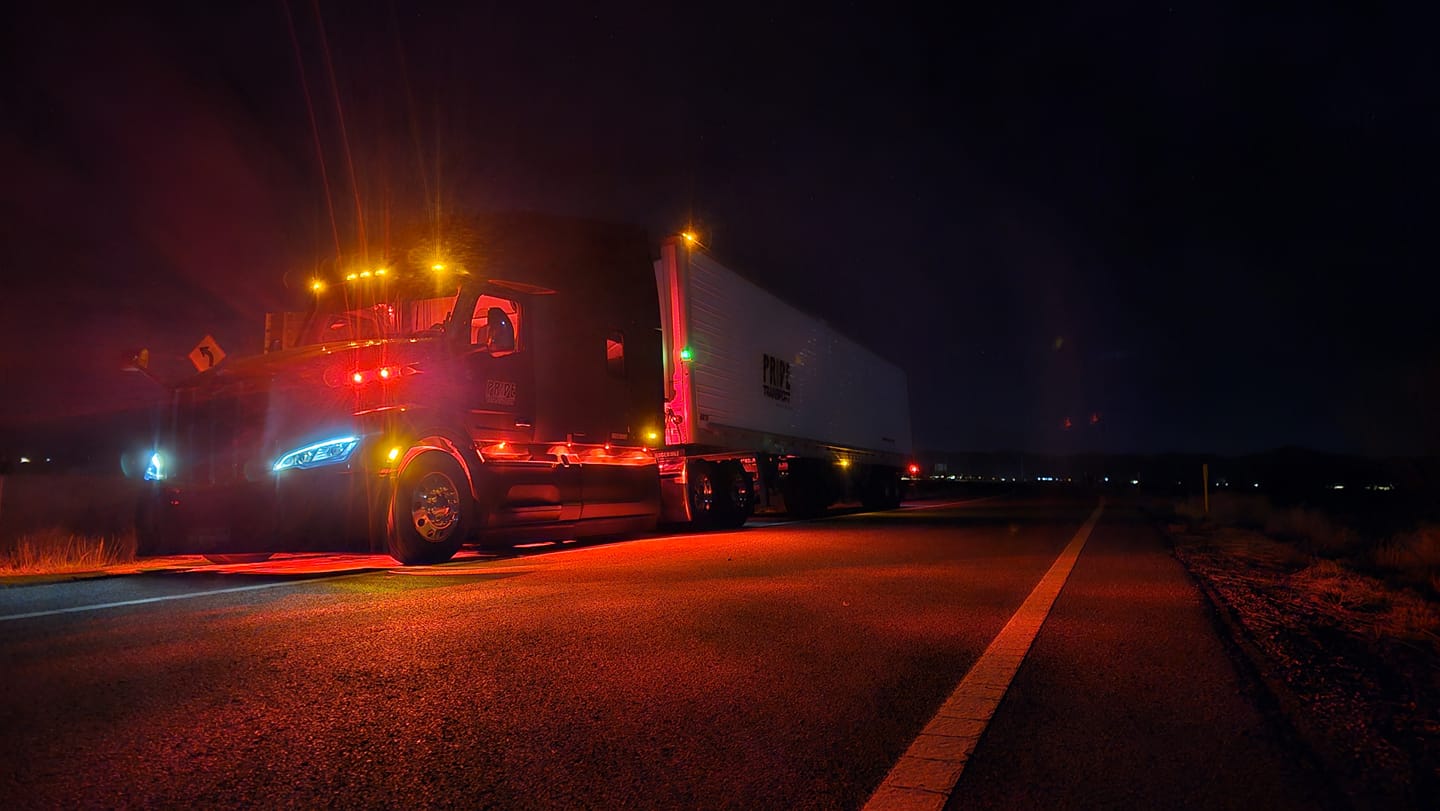by Pride Transport | May 24, 2024
Driving safely in the dark isn’t always easy. In fact, it’s one of the deadliest times to drive. According to the U.S. Department of Transportation Federal Highway Administration, around half of all traffic fatalities happen at night despite the fact that only around a quarter of all travel occurs then. Additionally, driver impairment and inattention are two leading causes of crashes (5.2% of deadly collisions) and are often linked to issues such as fatigue.
Driving at night is common for truck drivers, though. After all, what better way to move truckloads than to be on the roads when few others are?
It makes sense, but several issues can crop up that make drives feel long and tedious on overnight shifts. For example, you might start to feel drowsy and need to pull over, which can prolong your drive. Or, you might be prone to headaches or blurry vision as the lighting around you irritates your eyes.
Fortunately, there are tips that can help you stay awake and avoid drifting off or causing an accident. Here are a few to keep in mind before you get behind the wheel.

5 Tips for Safely Driving at Night
Driving at night has the potential to be tough on the body and mind, but by keeping these tips in mind, you’ll be on your way to a better drive.
1. Use the Right Lighting
To drive safely at night, one thing to try is turning your low-beam or dipped headlights on. Using high beams might help improve visibility in very dark areas, but you could accidentally blind the drivers coming from the other direction because the lights are so bright.
Interestingly, low beams have also been shown to improve safety during the day, too, especially at sunrise, at sunset, and during inclement weather.
2. Settle Into Your Cab
It can be easy to get distracted by any little thing at night, and you could develop a headache from bright lights on or around the road. You can’t control all aspects of the drive, but you can control the lighting within your cabin.
To cut down on distracting light, turn down your front dashboard. Doing so will help prevent it from reflecting on your windshield, so you have better visibility. You can use your dimmer switch to do this.
3. Eat Well for the Road
One way to help you stay focused on the road is by eating healthily. When you eat healthy food, you give your body the nutrients it needs to work well. Skipping out on the fast food stop is a good idea if you’re planning on driving late into the night.
Additionally, eating can trigger hormones that promote sleepiness and reduce brain activity and cognitive function — all things you don’t want to have happen behind the wheel.
Does that mean you should skip meals at night? No, absolutely not. Instead, consider swapping to a plant-based diet or saving meals for break times when you have time to grab a quick nap to refresh yourself.
4. Pull Over When Tired
Everyone is prone to getting tired on a long drive. Recognize the signs, so you can pull over and rest instead of moving forward when you’re more likely to doze off.
Common signs of fatigue include:
- Hitting a rumble strip
- Drifting into another lane
- Forgetting the last few miles
- Rubbing your eyes
- Catching yourself nodding off
- Yawning
Don’t let sleep get the better of you. Pull over and grab a coffee if you only have a short way to go. If you can, take a power nap (15 minutes) before the caffeine kicks in, and you’ll be much better off. If you find yourself tired even after doing these things, call it a day, pull over, and go to sleep.
5. Listen to Your Favorite Songs
Music is a good way to stay awake on long drives, but the type of music you listen to matters. High-tempo music is more energetic than other kinds, so it is very unlikely to lull you to sleep. It’s kind of like the difference between heavy metal and a lullaby — the lullaby is more likely to make you feel sleepy by virtue of being slower and more relaxing.
There are two caveats to driving while listening to music:
- Remember that volume can impact your concentration, so you shouldn’t “turn up the beat” too loud.
- Music with an extreme pace (over 80 beats per minute) has been linked to riskier driving, such as underestimating how fast the vehicle is moving. It can also lead to weaving and running red lights or stop signs.
With those facts in mind, consider listening to music with between 60 and 80 beats per minute (BPM).
Special Focus: Dealing With an Astigmatism at Night
Astigmatisms make night driving dangerous. Astigmatism can cause halos, glare, and blurriness that make a normally easy drive difficult.
There are some options to help, though. You should go to your annual eye exam (or schedule one early if you’re noticing signs like having blurry vision) and discuss medical devices such as:
- Glare-reduction lenses
- Prescription glasses that correct your astigmatism
- Orthokeratology contacts (Ortho-K), which you wear when you sleep. These lenses correct the shape of the cornea for better vision.
Sometimes, eye surgery (such as LASIK, PRK, SMILE, and Epi-LASIK) can also be an effective option. Speak with your optometrist or ophthalmologist about your eyesight, your career, and the options available to help you see better at night.
Ready to Hit the Road? Drive With Pride Transport
As you get ready to drive at night, remember there are several ways to improve the chances of a safe drive. From changing the kind of lighting around you to getting glasses or contacts when you need them, even a small change can make a big difference in how well you can see and pay attention at night.
At Pride, we focus on safety. From training until you’re on the road, we’ll give you the right tools to help keep you safe. Are you looking for your next role? Check our job openings to drive with Pride.
